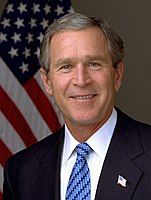|
2004 United States presidential election in New Jersey
The 2004 United States presidential election in New Jersey took place on November 2, 2004, and was part of the 2004 United States presidential election. Voters chose 15 representatives, or electors to the Electoral College, who voted for president and vice president. New Jersey was won by Democratic nominee John Kerry by a 6.68% margin of victory. Prior to the election, most news organizations considered it as a state Kerry would win, or a blue state. Due to the impact of the September 11, 2001 attacks, however, and Governor James McGreevey's resignation following threats of a sexual harassment lawsuit, the state was considered a potentially closer than usual race. Polls showed Senator John F. Kerry with a slim lead throughout the campaign and the Republicans invested some campaign funds in the state. In the end, Kerry carried New Jersey by a somewhat comfortable margin, albeit narrower than usual for most other 21st-century Democrats. This is the first time since 1880 in which the Republican nominee won the popular vote without New Jersey, and the first time it voted for the popular vote loser since 1976. To date, this is the last election in which the Republican candidate won Somerset County. PrimariesCampaignPredictionsThere were 12 news organizations who made state-by-state predictions of the election. Here are their last predictions before election day.[1]
PollingKerry won most preelection polls taken in this state albeit by small margins. The final 3 polling average showed the Democratic leading 49% to 42%.[2] FundraisingBush raised $5,934,011.[3] Kerry raised $6,513,274.[4] Advertising and visitsPresident George W. Bush visited Marlton, New Jersey, in Burlington County for a rally on October 18, 2004.[5] AnalysisGenerally, Kerry was very dominant in the urban centers of the state, particularly in Essex, Hudson, and Camden Counties. However, Bush made inroads in Bergen County, where many wealthy residents reside, and in other South Jersey counties. Bush controlled largely rural parts of the state, such as the Northwest (Hunterdon, Somerset, and Morris are also among the 10 wealthiest counties in America) and Salem County. Monmouth County's wealthy population and Ocean and Cape May Counties' older population also contributed to Bush's relative success in this largely Democratic state. This would also be the first election in which a Northern Democrat carried New Jersey since 1960 when fellow Massachusetts Democrat John F. Kennedy did so. The previous three Democratic presidential candidates to carry the state were all from the South (Lyndon B. Johnson was from Texas, Bill Clinton from Arkansas, and Al Gore from Tennessee), even though New Jersey is a northern state. This is the first time a president was elected twice without ever carrying any of the state's electoral votes either time, and only the second occasion (after 1864) that any president won two terms without ever carrying the state's popular vote either time. Results
By county -Blue municipalities won by Kerry -Red municipalities won by Bush
Counties that flipped from Democratic to Republican
By congressional districtKerry won 7 of 13 congressional districts.[8]
ElectorsTechnically the voters of NJ cast their ballots for electors: representatives to the Electoral College. NJ is allocated 15 electors because it has 13 congressional districts and 2 senators. All candidates who appear on the ballot or qualify to receive write-in votes must submit a list of 15 electors, who pledge to vote for their candidate and his or her running mate. Whoever wins the majority of votes in the state is awarded all 15 electoral votes. Their chosen electors then vote for president and vice president. Although electors are pledged to their candidate and running mate, they are not obligated to vote for them. An elector who votes for someone other than his or her candidate is known as a faithless elector. The electors of each state and the District of Columbia met on December 13, 2004, to cast their votes for president and vice president. The Electoral College itself never meets as one body. Instead the electors from each state and the District of Columbia met in their respective capitols. The following were the members of the Electoral College from the state. All 15 were pledged for Kerry/Edwards.[9]
See alsoReferences
External links |
|||||||||||||||||||||||||||||||||||||||||||||||||||||||||||||||||||||||||||||||||||||||||||||||||||||||||||||||||||||||||||||||||||||||||||||||||||||||||||||||||||||||||||||||||||||||||||||||||||||||||||||||||||||||||||||||||||||||||||||||||||||||||||||||||||||||||||||||||||||||||||||||||||||||||||||||||||||||||||||||||||||||||||||||||||||||||||||||||||||||||||||||||||||||||||||||||||||||||||||||||||||||||||||||||||||||||||||||||||||||||||||||






